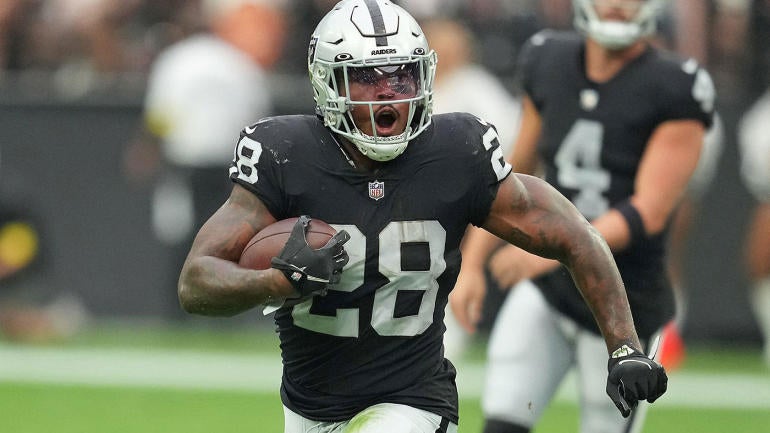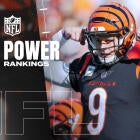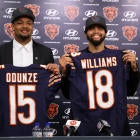
Running backs can't be blamed for feeling as if they are being treated like a stepchild. NFL teams exercised fiscal restraint in free agency. Miles Sanders couldn't capitalize on a 2022 season with the Eagles where he had career highs of 1,269 rushing yards and 11 rushing touchdowns, which were fifth and eight in the NFL, respectively. His four-year, $25.64 million contract with the Panthers, averaging $6.35 million per year where $13 million was fully guaranteed, set the free agent running back market.
The next best deal belongs to David Montgomery. He went to the Lions for $18 million over three years. There are $11 million in guarantees, of which $8.75 million was fully guaranteed at signing in Montgomery's $6 million-per-year deal.
None of the three running backs (Saquon Barkley-Giants, Josh Jacobs-Raiders and Tony Pollard-Cowboys) designated as franchise players for $10.091 million have signed long-term deals. Barkley expressed frustration with "misleading" leaks about his negotiations over the weekend at his youth football camp in Jersey City, New Jersey, in advance of the Giants' mandatory minicamp being held June 13-15, which he isn't attending.
The NFL's 2018 Offensive Rookie of the Year took issue with being portrayed as "greedy" for reportedly turning down a $13 million-per-year deal worth as much as $14 million per year with incentives before the March 7 deadline for teams to use a franchise tag. The Giants surprisingly pulled their offer instead of just tabling discussions after an impasse was reached in March.
Barkley didn't dismiss sitting out the season, which is likely just posturing, if he doesn't have a new contract by the 4 p.m. ET deadline on July 17 for franchise players to sign long term. After the deadline passes, players with franchise tags are prohibited from signing multiyear contracts until the end of the regular season on Jan. 7, 2024.
Jacobs suggested he is taking a stand for future running backs in his contract dispute with the Raiders. His financial demands are unknown. Jacobs had a career year in 2022. He led the NFL in both rushing and yards from scrimmage (combined rushing and receiving yards) with 1,653 and 2,053 yards, respectively, to earn All-Pro honors.
Typically, when a player has a contract-year performance like Jacobs', financially capitalizing on the success is usually a given at most other positions. If Jacobs wasn't a running back, he would have a legitimate chance at replacing Christian McCaffrey as highest paid at the position because of his 2022 production. McCaffrey signed a four-year contract extension with the Panthers, averaging $16,015,853 per year with $39,162,500 of guarantees, in 2020. He has a running back-best $30,062,500 fully guaranteed at signing.
The number of running backs making at least $12 million per year has dwindled. There were eight such running backs at the end of the 2022 season. Five running backs (McCaffrey, Alvin Kamara-Saints, Derrick Henry-Titans, Nick Chubb-Browns and Joe Mixon-Bengals) remain at or above the $12 million-per-year mark.
The Cowboys released Ezekiel Elliott in March following a 2022 season that was the worst of his seven-year NFL career. Elliott had been the NFL's second-highest-paid running back at $15 million per year. The two-time rushing champion signed a six-year, $90 million extension in 2019 when he had two years left on his rookie contract.
Aaron Jones took a pay cut from the backloaded four-year, $48 million contract he signed in 2021 to remain with the Packers. He reduced his 2023 compensation from $16 million to $11 million while leaving his $12 million salary in 2024 intact rather than risk the Packers parting ways with him. Jones made $20 million over the first two years of his deal.
The Vikings recently released Dalvin Cook, who signed a five-year, $63 million extension in 2020, after four straight seasons of rushing for more than 1,100 yards. Cook is being replaced by a much cheaper Alexander Mattison, who was Cook's backup during those seasons. Mattison returned to the Vikings on the two-year, $7 million deal worth a maximum of $8 million through incentives he received in free agency.
The situation is probably going to get worse with high-end running back salaries next offseason. Henry, who signed a four-year, $50 million deal, averaging $12.5 million per year (worth a maximum of $51 million through incentives), with the Titans in 2020, has an expiring contract. As a 30-year-old free agent in 2024, Henry shouldn't expect a contract comparable to his current deal. Mixon probably needs to bounce back from a 2022 season in which he had 814 rushing yards to see the final year of the four-year, $48 million he signed with the Bengals in 2020.
History suggests that the economic downturn with high-priced running backs may be cyclical. Adrian Peterson and Chris Johnson took running back salaries to a new level in 2011 after several years of stagnation by signing deals that put them among the NFL's five highest-paid non-quarterbacks.
Johnson signed a four-year extension with the Titans, averaging $13,493,750 per year and containing $30 million in guarantees, after a lengthy preseason holdout. Peterson subsequently received a six-year, $85.28 million extension, averaging $14,213,333 per year, which included $36 million in guarantees and an additional $4 million in base salary escalators, from the Vikings.
The running back market started steadily declining a couple of years later before hitting a low point in 2017. There no longer were any running backs with multiyear contracts averaging $10 million per year or more. The highest-paid running back was Devonta Freeman with the five-year extension, averaging $8.25 million per year, he received from the Falcons that preseason.
A reversal started occurring in 2018 when the Rams signed Todd Gurley to a four-year, $57.5 million extension (worth a maximum of $60 million through salary escalators) with $45 million in guarantees. At $14.375 million per year, Gurley's deal represented an almost a 75% increase over Freeman's extension. Gurley's substantial market increase averaged just over 1 percent more than Peterson's 2011 deal.
David Johnson helped proved Gurley's deal wasn't a market anomaly. Hours before the Cardinals' 2018 regular-season opener, Johnson signed a three-year, $39 million extension with $31,882,500 of guarantees. The deal was worth as much as $45 million through incentives.
Le'Veon Bell further solidified the dramatic reset of the running back market Gurley started during 2019 free agency. The two-time All-Pro signed a four-year, $52.5 million contract ($13.125 million per year) with the Jets, containing $35 million in overall guarantees, after sitting out the entire 2018 season rather than playing on a second straight franchise tag. Incentives and salary escalators made the maximum value of the deal $60.15 million.
Elliott replaced Gurley as the NFL's highest-paid running back shortly before the 2019 regular season started when he ended his nearly 40-day holdout from the Cowboys. He became the first running back in the league history to sign a $100 million contract. Elliott established new standards for running backs with $50,052,137 in overall guarantees and $28,052,137 fully guaranteed at signing, which McCaffrey later eclipsed. McCaffrey took the mantle from Elliott and has remained the running back standard bearer since signing in April 2020.
There are a couple of obstacles that must be overcome to stop the downward running back salary spiral. Too many teams haven't gotten a good return on investment with high-end running backs since Gurley started the salary escalation.
Those first three deals by Gurley, Johnson and Bell each can be used as cautionary tales. The Rams released Gurley in 2020 following a lackluster 2019 campaign in which he rushed for a career-low 857 yards. Gurley didn't play any of his new contract years since his four-year extension ran from 2020 through 2023. The 2017 NFL Offensive Player of the Year made out like a bandit from the deal. Gurley was $20 million better off from the extension than playing out his rookie contract. After playing the 2020 season under a one-year deal for $5.5 million (worth up to $6 million through incentives) with the Falcons, Gurley never signed another NFL contract.
Bell's first year with the Jets was underwhelming. He rushed for 789 yards while averaging 3.2 yards per carry in 2019. The Jets pulled the plugged on a disgruntled Bell by releasing him five games into his second season in New York. He subsequently signed a one-year contract with the Chiefs worth approximately $706,000 in base salary for the rest of the season. Bell made just over $27 million for his 21-game stay in New York.
Johnson fell out of favor with the Cardinals in 2019 after Kenyan Drake was acquired as the late-October trading deadline was approaching. The Cardinals dealt Johnson, a 2020 second-round pick and a 2021 fourth-round pick to the Texans in 2020 for wide receiver DeAndre Hopkins and a 2020 fourth-round pick. Johnson was expected to be the focal point of the Texans' offense but wasn't able resurrect his career with the change of scenery. He never came close to his last highly productive season from 2016 when he led the NFL with 2,118 yards from scrimmage and 20 touchdowns, which got him paid in the first place.
Elliott started trending in the wrong direction statistically after signing his record-breaking contract. He had 231 rushing attempts for 876 rushing yards with 3.8 yards per carry, all career lows last season. Elliott caught 17 passes for 92 yards, which were more career worsts.
Durability concerns and a 1-4 start to the 2022 season, which led to the firing of head coach Matt Rhule, prompted the Panthers to deal McCaffrey to the 49ers for 2023 second-, third- and fourth-round picks as well a 2024 fifth-round pick near the trading deadline. Prior to becoming the NFL's highest-paid running back in 2020, McCaffrey had been an ironman. McCaffrey was on the field for 92.4% of Carolina's offensive snaps (2,005 of 2,171 plays) during the previous two seasons. His playtime was easily the most for an NFL running back in that span.
It was a different story after McCaffrey got his big payday. He missed 23 of 33 games over the 2020 and 2021 seasons. McCaffrey quickly demonstrated his skills hadn't diminished once he got to San Francisco.
There's a school of thought in the NFL that a team should avoid giving a running back an extremely lucrative second contract unless he's a special talent. The preference under this philosophy is to find a feature running back in the NFL Draft, don't be overly concerned about managing workload during the rookie contract and go year to year with franchise or transition tags, when warranted, until no longer economically feasible. Simultaneously, an attempt to find a suitable replacement in the draft should be made either toward the end of the rookie contract or while the veteran is playing under a designation. The veteran should only be re-signed on team-friendly terms. This protects against overpaying while a running back is in his late 20s when he is likely to be in decline because of high mileage and there are diminishing returns.
This line of thinking exists because productive ball-carriers can be found all over the draft. Kamara was the NFL's 2017 Offensive Rookie of the Year as a third-round pick. The Chiefs won Super Bowl LVII with 2022 seventh-round pick Isiah Pacheco as the primary ball-carrier despite the presence of 2020 first-round pick Clyde Edwards-Helaire. Pacheco started emerging even before a high ankle sprain in Week 11 sidelined Edwards-Helaire, who was a healthy scratch in the Super Bowl. The philosophy may continue to gain traction because enough running backs paid at the highest level have underperformed on second contracts.
Barkley's venting has had one positive effect. The Giants have reportedly put the March offer back on the table. Whether an agreement is reached before the July 17 deadline could hinge on structure (total guarantees, amount fully guaranteed at signing, cash flow, etc.). A timely Barkley deal could be the catalyst for Jacobs signing long term.
Regardless of the outcome with Barkley and Jacobs, there is another situation worth watching: 2020 second-round pick Jonathan Taylor is scheduled to play the 2023 season -- which is his contract year -- for $4.304 million.
The Colts have a track record of extending the contracts of core players in the final year of rookie deals. Taylor, coming off a 2022 season where he had a career-low 861 rushing yards in 11 games behind an inconsistent offensive line, while being slowed by a right ankle injury (which required offseason surgery), complicates matters. His 2022 performance is in stark contrast to a stellar 2021 season in which Taylor was easily the league's best running back.
Taylor led the NFL with 2,171 yards from scrimmage, 1,811 rushing yards, 20 total touchdowns and 18 rushing touchdowns. He won the rushing title by 552 yards while averaging 5.5 yards per carry. Since entering the NFL, Taylor ranks third in yards from scrimmage (4,643), fourth in rushing yards (3,841) and fourth in touchdowns (36).
The Colts may be set up to handle a lucrative running back contract. There shouldn't be a high-priced quarterback for the foreseeable future after selecting Anthony Richardson with the fourth overall pick in this year's draft.
Teammates Quenton Nelson and Shaquille Leonard reset the offensive guard and off-ball linebacker markets last year and in 2021, respectively. It's hard to imagine the Colts doing the same for Taylor, who is 24, given his 2022 season even though the running back market is due for a reset. The only positional market that hasn't increased since McCaffrey signed more than three years ago is running back.





















